The Genesis and Development of Landscape Painting
So firmly established is the landscape as a genre of art that one would be forgiven for assuming its origins are coeval with those of painting itself. Yet, while we find a few early instances of what might be called a landscape – palace walls in Crete, for instance, or certain frescoes in Pompeii – the landscape does not in fact become an established, independent genre until the 17th century. The process by which this occurred is unraveled in “The Genesis and Development of Landscape Painting,” an exhibition at the Bunkamura Museum of Art presenting 70 paintings on loan from the Kunsthistorisches Museum in Vienna.
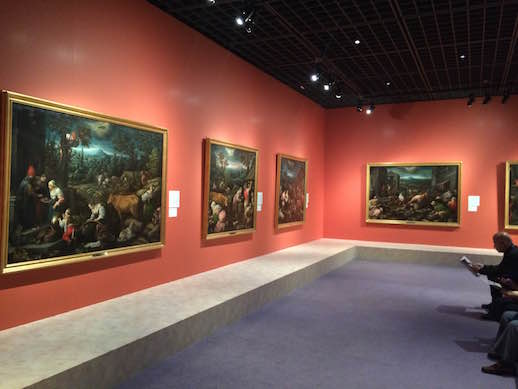
The exhibition begins in the early 16th century, just as the Quattrocentro has drawn to a close and canvases have begun to replace wooden panels. Within the next few decades, oil painting will have rendered tempera almost obsolete. Michelangelo is at work on the Sistine Chapel. At this point, the landscape is still mere background, usually to religious or mythological scenes, its features always idealized and Italianate – rolling verdant hills, silver rivers, low mountains. One or two cities rise among them in the distance, but they too seem idealized, as though not truly meant for human habitation. (Unlike in other European countries, in Italian art there seems to be a tradition of representing cities as empty, desolate spaces – Piero della ‘Francesca’s View of an Ideal City,’ or ‘The Carceri of Piranelli,’ for example). The features of these paintings often provide figural accents to the actions depicted – a mountain is positioned so as to rise directly over the head of the resurrected Christ as he exits the tomb; an undulant rock formation echoes the body of Mary Magdalene as she reclines in front of it. There is the order of human actions and human destinies, and to this order Nature must faithfully comply.
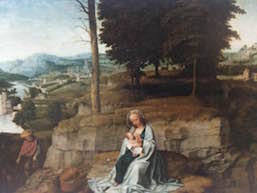
These painters used increasingly lighter shading to create a sense of distance in the landscape. An unexpected effect of this technique can be seen in Adriaen Isenbrant’s ‘Rest on the Flight to Egypt’ (1520). When the eye first takes in the painting as simply an organized array of color and form, it perceives a foreground figure in blue surrounded by warmer, earthier colors, which in turn shift to light green, then the blue of the foreground, which fades into the distance. After this brief impression, the painting comes into focus – it is a Madonna, and the figure in front is the Virgin Mary nursing the infant Christ. But the first impression is not erased – Mary’s pale blue garment attaches her to the pale blue mountains that mark the horizon. It is as though she is saying, “I am here, yes, but under the sign of a world which lies beyond the horizon of this one.” This same tension haunts many paintings from this period; it is there in the foreknown mourning of the Virgin’s face even as she gazes at her child, as it is present in the white cities that crown the untraversable distances of these very landscapes.
A more prominent use of landscape emerges in the Reformation countries of Northern Europe. In paintings from the Quattrocento, light often indicates a transcendence of the world. In Fra Angelico’s ‘The Coronation of the Virgin,’ for instance, an unearthly effulgence envelops the witnesses of the blessed event, while Piero della Francesco’s ‘The Baptism of Christ’ shows a descending dove touched with a radiance that sets it apart from its surroundings. Most astonishing, however, is Raphael’s ‘Deliverance of Saint Peter.’
By contrast, in the Netherlandish/Protestant painting of the ensuing centuries, light is a way of partaking of the world, of being incorporated into it. The question of how to reconcile the Beyond with the Here, or the Ideal with the Real, suddenly seems purely academic. Bereft of the recondite symbolism and monarchic values of Catholic art, Netherlandish/Protestant painting responds to humbler, more immediate questions: do we not wish to impart a meaning onto those places we inhabit, and which we share with those for whom we care? Before many of these Protestant paintings, such as Hans Bol’s ‘Flemish Village Life’ (1562), one senses a joy as though the artist had accomplished this – in true Protestant fashion, they are laboring together to create the kingdom of God (“The kingdom of God is among you”). Note the paintings from the Reformation and Counter-reformation show difference in how this phrase was interpreted; the former generally read it as communal and productive, whereas the latter construed it as institutional and restrictive. The expanses of land, brimming with rustic golds and shades of bronze, are warm and nutritive, like a great loaf of bread to be divided and shared, or a hearth before which all warm themselves. It is as though the phrase “in the fullness of time” referred not to the historical moment of Christ’s birth, never to be repeated, but to the irrepressible surging of the present moment.
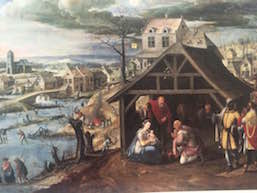
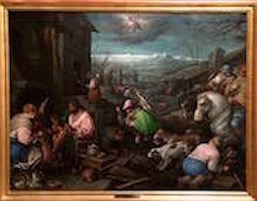
The exhibition’s largest section is devoted to two calendrical series, one by the Netherlandish painter Marten van Valckenborch (a student of Peter Breughel) and the other by the Italian painter Leandro Bassano (a student of Tintoretto). Together, they illustrate something of the difference in artistic styles between the Reformation and the Counter-Reformation. In Marten van Valckenborch’s ‘Adoration of the Magi (January)’ from 1585, the adoration of the holy infant occurs in the foreground, but has been shunted off to the right to make room for a view opening onto a typical northern European town. We see the adventures and misadventures of townspeople crossing a frozen river, a ladder-borne man hacking at the dead tree branches, rows of gabled houses, and, on a hill in the distance, the blades of a windmill cutting the air as lightly as dragonfly wings. Here is a painter who has divorced himself from the dreamy Italianate landscape and created archetypes from the land he knows and inhabits. The mythic and the everyday, the two halves of this painting, are not meant to be contrasted; they co-exist. Adoration for the newborn Christ is not an inaccessible historical event; it is immanent in the lives of the community.
After viewing such a warm and communal series as Marten van Valckenborch’s, it is jarring to encounter Bassano’s. Here, even in the summer months, the sky has a dark, menacing hue, the light as irreal as that in the shortened days of winter at extreme northern latitudes. The individual workers strut across the foreground like actors on a stage, while the space behind them, whether urban or rural, is flat and desolate. Though some of them are working together, their labor remains forced and joyless, Hesiodic. Rather than actively produced, hope is to be symbolized by a single green-clad figure in each of the tableaux.
A shift in religious temperament may have prepared the ground for landscape painting, but ultimately economic factors would establish it. Unlike the more aristocratic genres of religious and historical painting, landscape came of age in the proto-capitalistic environment of Antwerp in the 16th and 17th centuries; the vast majority of paintings were to be sold to the lower classes and bourgeoisie in open-air art markets (Antwerp was home to the very first one, located near the Bourse). These classes did not want scenes from the grand humanist tradition, but from the “lower categories” of still-lifes, landscapes, and genre paintings, among others. In the 17th century this surge of artistic activity reached its head – Jonathan Israel has estimated that 1.3 million Dutch pictures were produced between the years of 1640 and 1660 alone. The market for these pictures naturally produced competition amongst artists, which in turn led to increased specialization – it is rare to find a Dutch painter from this period who consistently produces work in multiple genres. For some artists, the choice to specialize in landscapes must have been born of opportunism. Although these landscapes tend to have an air of pastoral tranquility, we can hear behind them the shouts of auctioneers, the rattling of coins, the bustle of crowds.
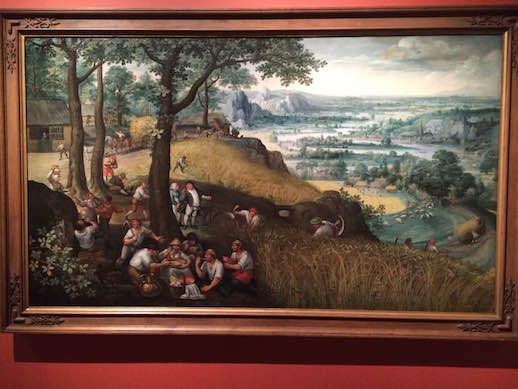
Thus, in Lucas van Valckenborch’s ‘Landscape in Summer’ (1585), the heightened vantage point afforded by the landscape is used to show the extent of commercial enterprise – wagons freighted with sheaves of wheat head down roads leading to various settlements, while the proprietor, as the focal figure of the painting, stands on the hilltop and surveys his prosperity. He sees not “Nature” but plots of land with an expected yield; not empty, winding roads, but trade routes; not unreachable cities, but future markets (we can see why it was commonplace at the time to joke that the Dutch hated all metaphysical or theological speculation). The owner of this painting would likely have been much like this proprietor, an ascendant bourgeois who could see in this painting not only the realization of his efforts, but also the confirmation of his prospects. The generic figures that populate the painting, such as the laborers and reveling peasants, would have been used perhaps only because they had been proven popular in paintings by other artists (in fact, this painting takes quite a few cues from Breughel’s ‘The Harvesters’).
However, after the “boom” years of the first half of the 17th century, the Dutch art market stalled and crashed in the second, largely due to overproduction and military catastrophes. Rembrandt, van Goyen, and Hals all faced bankruptcy; Vermeer left his wife in arrears after his death in 1675. Unsurprisingly, the landscapes of this period are not as optimistic; there is the sense of an era coming to an end. Scenes that had previously been bounteous expanses of promise are now mixed with a certain melancholy. A perception of the fleetingness tempers the earlier “fullness.” Shadows creep in and sometimes dominate. The revelers and laborers have disappeared, and in their place are a few, if any, solitary figures, who do not partake of the land around them, but wander on its surface. They seem to ask, “Is it possible to live otherwise than at the curving of roads, upon the mere surface of things?” Ruisdael’s ‘Landscape with a Mountain Stream’ (1670-1680) shows a scene that appears as though it should be peaceful and comforting, but the weight of the shadows, the occlusion of the horizon, and the minute, solitary man walking in the middle ground all create an air of something between disquiet and resignation. In short, after the radiant light of past landscapes, evening has fallen, and it is at this point that the exhibition concludes.
(All photography by Parker Thomas.)
Parker Thomas
Parker Thomas



